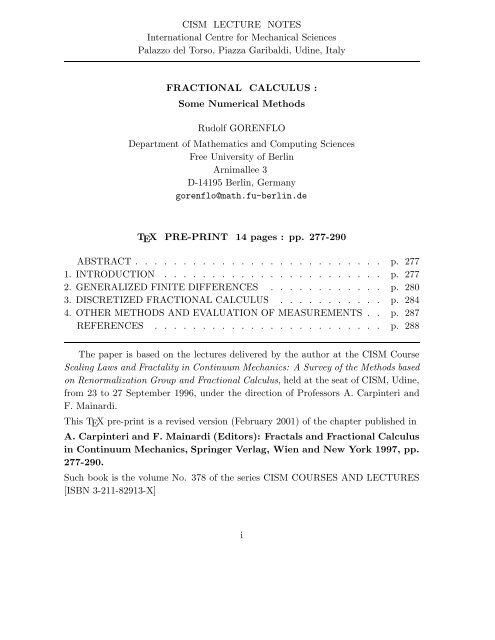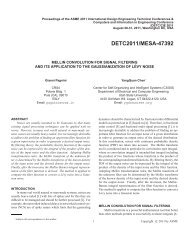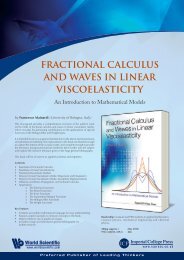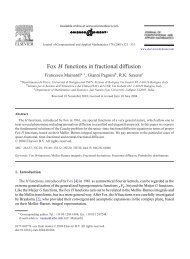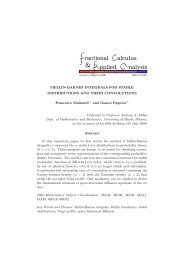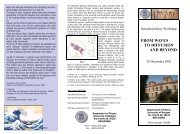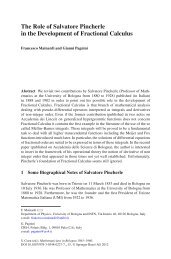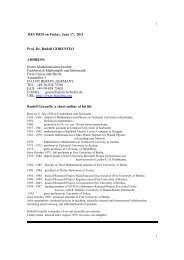CISM LECTURE NOTES International Centre for Mechanical Sciences
CISM LECTURE NOTES International Centre for Mechanical Sciences
CISM LECTURE NOTES International Centre for Mechanical Sciences
You also want an ePaper? Increase the reach of your titles
YUMPU automatically turns print PDFs into web optimized ePapers that Google loves.
<strong>CISM</strong> <strong>LECTURE</strong> <strong>NOTES</strong><br />
<strong>International</strong> <strong>Centre</strong> <strong>for</strong> <strong>Mechanical</strong> <strong>Sciences</strong><br />
Palazzo del Torso, Piazza Garibaldi, Udine, Italy<br />
FRACTIONAL CALCULUS :<br />
Some Numerical Methods<br />
Rudolf GORENFLO<br />
Department of Mathematics and Computing <strong>Sciences</strong><br />
Free University of Berlin<br />
Arnimallee 3<br />
D-14195 Berlin, Germany<br />
gorenflo@math.fu-berlin.de<br />
TEX PRE-PRINT 14 pages : pp. 277-290<br />
ABSTRACT . . . . . . . . . . . . . . . . . . . . . . . . . . p. 277<br />
1. INTRODUCTION . . . . . . . . . . . . . . . . . . . . . . . p. 277<br />
2. GENERALIZED F INITE DIF F ERENCES . . . . . . . . . . . . p. 280<br />
3. DISCRETIZED F RACTIONAL CALCULUS . . . . . . . . . . . p. 284<br />
4. OTHER METHODS AND EVALUATION OFMEASUREMENTS . . p. 287<br />
REF ERENCES . . . . . . . . . . . . . . . . . . . . . . . . p. 288<br />
The paper is based on the lectures delivered by the author at the <strong>CISM</strong> Course<br />
Scaling Laws and Fractality in Continuum Mechanics: A Survey of the Methods based<br />
on Renormalization Group and Fractional Calculus, held at the seat of <strong>CISM</strong>, Udine,<br />
from 23 to 27 September 1996, under the direction of Professors A. Carpinteri and<br />
F.Mainardi.<br />
This TEX pre-print is a revised version (February 2001) of the chapter published in<br />
A. Carpinteri and F. Mainardi (Editors): Fractals and Fractional Calculus<br />
in Continuum Mechanics, Springer Verlag, Wien and New York 1997, pp.<br />
277-290.<br />
Such book is the volume No. 378 of the series <strong>CISM</strong> COURSES AND <strong>LECTURE</strong>S<br />
[ISBN 3-211-82913-X]<br />
i
c○ 1997, 2001 Prof. Rudolf Gorenflo - Berlin - Germany<br />
rgcism10.tex, rgcism.tex, = versions in plain TEX, 14 pages.<br />
ii
FRACTIONAL CALCULUS :<br />
Some Numerical Methods<br />
R.Gorenflo 277<br />
Rudolf GORENFLO<br />
Department of Mathematics and Computing <strong>Sciences</strong>, Free University of Berlin<br />
Arnimallee 3, D-14195 Berlin, Germany<br />
e-mail: gorenflo@math.fu-berlin.de<br />
ABSTRACT<br />
A survey is given on some numerical methods of Riemann-Liouville fractional<br />
calculus. The topics discussed here will be: (a) approximation of fractional derivatives<br />
by generalized finite differences and their use in numerical treatment of fractional<br />
differential equations, (b) discretized fractional calculus and its use in numerical<br />
treatment of Abel type integral equations of first and second kind, (c) product<br />
integration and collocation methods <strong>for</strong> Abel integral equations, (d) the problem<br />
of ill-posedness of Abel integral equations of first kind.<br />
1991 Mathematics Subject Classification: 26A33, 45E10, 45J05, 65L12, 65R30.<br />
1. INTRODUCTION<br />
We shall describe and discuss a few methods of numerical treatment of ordinary<br />
fractional differential equations and Abel integral equations of first and second kind.<br />
This research was partially supported by the Research Commission of Free<br />
University of Berlin. The author is grateful to the National Research Council (CNR)<br />
of Italy <strong>for</strong> the support given in occasion of an extended visit to University of Bologna<br />
in the framework of the Programme of Visiting Professors of the National Group <strong>for</strong><br />
Mathematical Physics (GNFM). He appreciates the good cooperation he has with<br />
Professor Francesco Mainardi in theory and applications of fractional calculus.
278 Fractional Calculus: Some Numerical Methods<br />
There exists a rich literature on these subjects, Abel integral equations being a special<br />
sort of Volterra integral equations, and much material and many references on theory<br />
and practice can be found in the books by Brunner and van der Houwen [1] and by<br />
Linz [2]. For the analytical theory of the relevant fractional integral and differential<br />
operators we recommend the books by Samko, Kilbas and Marichev [3] and by K.S.<br />
Miller and B. Ross [4]. Let us also mention the book by Gorenflo and Vessella [5].<br />
Concerning the basic theory of fractional differential equations and their applications<br />
and references we refer the reader to the papers by Gorenflo and Mainardi [6] and<br />
by Mainardi [7] that he will find in this volume.<br />
The linear operators occurring in the sequel and to be approximated are the Riemann-Liouville<br />
operator J α of fractional integration and the operator D α of fractional<br />
differentiation, α being nonnegative.<br />
Here we do not hesitate to repeat the definitions introduced in [6] in order to<br />
make this contribution self-consistent. The operator J α is defined by the <strong>for</strong>mula<br />
J α u(t) := 1<br />
Γ(α)<br />
t<br />
whereas its left-inverse D α is given as<br />
0<br />
(t − τ) α−1 u(τ) dτ, t > 0 , α > 0 , (1.1)<br />
D α := D m J m−α , m− 1 0 .<br />
These <strong>for</strong>mulas, of course, require that the function u is sufficiently well behaved.<br />
We note the semigroup property<br />
and the <strong>for</strong>mula (<strong>for</strong> α ≥ 0)<br />
which means<br />
J α J β = J α+β<br />
<strong>for</strong> α ≥ 0, β≥ 0, (1.4)<br />
D α J α = I,<br />
D α J α u(t) =u(t). (1.5)<br />
Remark: In order to remain in accordance with the standard notation I <strong>for</strong> the<br />
Identity operator we use the character J <strong>for</strong> the integral operator and its power J α .
For convenience, we define the operator J α −∞ by<br />
R.Gorenflo 279<br />
J α −∞u(t) := 1<br />
t<br />
(t − τ)<br />
Γ(α) −∞<br />
α−1 u(τ) dτ , t ∈ IR , α > 0 . (1.6)<br />
If u(t) isacausal function, i.e. u(t) =0<strong>for</strong>−∞ −1, t>0. We have, <strong>for</strong> α ≥ 0, the relations<br />
J α t γ =<br />
Γ(γ +1)<br />
Γ(γ +1+α) tγ+α , D α t γ =<br />
Γ(γ +1)<br />
Γ(γ +1− α) tγ−α . (1.8)<br />
For proofs consult [3], [4] or [8].<br />
Note the remarkable fact that the fractional derivative Dαu is not zero <strong>for</strong> the<br />
constant function u(t) ≡ 1ifα∈ IN . In fact, (1.8) with γ = 0 teaches us that<br />
D α 1=<br />
1<br />
Γ(1 − α) t−α , α ≥ 0, t > 0. (1.9)<br />
This, of course, is ≡ 0<strong>for</strong>α ∈ IN, due to the poles of the gamma function in the<br />
points 0, −1, −2,.... Furthermore, we observe, again by looking at (1.8), that<br />
D α t α−1 ≡ 0 <strong>for</strong> t>0, α > 0,<br />
which implies that D α is not right-inverse to J α .Wehave<br />
J α D α t α−1 ≡ 0, but D α J α t α−1 = t α−1<br />
<strong>for</strong> t>0, α > 0.<br />
These matters cause some problems in numerical treatment of fractional<br />
differential and integral equations and require great care in analytical investigations.<br />
Everything would be more coherent if we would consistently work with the<br />
, m − 1 < α ≤ m, m ∈ IN, and with<br />
operators J α −∞ and Dα −∞ = DmJ m−α<br />
−∞<br />
generalized functions in the sense of Gel’fand and Shilov [9] instead of functions,<br />
these generalized functions vanishing <strong>for</strong> t
280 Fractional Calculus: Some Numerical Methods<br />
For numerical treatment of fractional differential and integral equations it is<br />
essential to have available good approximations of the operators D α and J α of<br />
fractional differentiation and integration. So, in Section 2 we shall discuss the<br />
approach of Grünwald [10] and Letnikov [11] <strong>for</strong> approximation of D α by generalized<br />
finite differences, and in Section 3 we shall describe the basic ideas of discretized<br />
fractional calculus as it has been developed by Lubich [12]. In Section 4 we shall<br />
give a short survey on literature on product integration and collocation methods <strong>for</strong><br />
Abel type integral equations, and on the problem of ill-posedness of Abel integral<br />
equations of first kind. This ill-posedness causes specific troubles in many situations<br />
where a situation of evaluation of physical measurements is modeled by use of an<br />
Abel integral equation of first kind (see [5], [8] and [13] <strong>for</strong> examples).<br />
Throughout, our presentation will be in<strong>for</strong>mal, all occurring functions being<br />
assumed to be so regular that what is written down is meaningful. For precise<br />
conditions of required smoothness etc. and <strong>for</strong> rigorous proofs the reader is advised<br />
to look into the quoted references.<br />
2. GENERALIZED FINITE DIFFERENCES<br />
For derivation of approximations to the fractional differentiation operator D α it<br />
is convenient to make use of the discrete operators of translation (shift) and finite<br />
differences. In a lucid way the theory of numerical differentiation and integration<br />
(with equidistant grid points) is developed in Chapters 7 to 10 of [14]. See also<br />
Chapter 6 of [15].<br />
Let be τ ∈ IR . Then we define the shifting operator E τ and the (backward,<br />
<strong>for</strong>ward, central) difference operators ∇τ ,∆τ and δτ by their action on a function<br />
u(t) defined <strong>for</strong> t ∈ IR.<br />
⎧⎪<br />
E<br />
⎨<br />
⎪⎩<br />
τ u(t) =u(t + τ) ,<br />
∇τu(t) =u(t) − u(t − τ) ,<br />
∆τu(t) =u(t + τ) − u(t) ,<br />
δτ u(t) =u(t + τ/2) − u(t − τ/2) .<br />
Obviously, the operators E τ <strong>for</strong> τ ∈ IR have the group property,<br />
(2.1)<br />
E σ+τ = E σ E τ , σ ∈ IR, τ ∈ IR , (2.2)<br />
meaning E σ E τ u(t) =E σ u(t + τ) =u(t + τ + σ), and it is <strong>for</strong> this reason that in E τ<br />
we use τ as an exponent instead of as an index. We furthermore have the relations,<br />
with I as Identity operator,<br />
∇τ = I − E −τ , ∆τ = E τ − I, δτ = 1<br />
<br />
E<br />
2<br />
τ/2 − E −τ/2<br />
<br />
, (2.3)<br />
and all operators of this group commute with each other.
R.Gorenflo 281<br />
With these notations, we can write the well-known approximations [u(t) − u(t −<br />
h)]/h and [u(t+h/2)−u(t−h/2)]/h <strong>for</strong> the derivative u ′ (t) of a differentiable function<br />
u(t) as[∇hu(t)]/h and [δhu(t)]/h, withh>0 small. For h → 0 these approximations<br />
have O(h) and O(h2 ), respectively, as order of accuracy, if the function u(t) is<br />
sufficiently smooth. See again [14] or [15].<br />
Higher order derivatives u (n) (t) =Dnu(t) withn∈IN can, with h>0 small, be<br />
approximated by<br />
[∇ n hu(t)]/hn = h −n (I − E −h ) n u(t)<br />
or<br />
[δ n h u(t)]/hn = h −n<br />
<br />
E h/2 − E −h/2<br />
n u(t)<br />
again in case of u(t) being sufficiently smooth, with order of accuracy O(h) orO(h2 ),<br />
respectively. The powers ∇n h and δn h can readily be expanded via the binomial<br />
theorem:<br />
∇ n h =<br />
n<br />
(−1) j<br />
<br />
n<br />
E<br />
j<br />
−jh ,<br />
δ n h =<br />
n<br />
(−1) j<br />
j=0<br />
j=0<br />
<br />
n<br />
E<br />
j<br />
(n−j) h/2 E −jh/2 n<br />
=<br />
j=0<br />
(−1) j<br />
<br />
n<br />
E<br />
j<br />
(n/2−j) h .<br />
This leads to the well known <strong>for</strong>mulas<br />
h −n<br />
n<br />
(−1) j<br />
<br />
n<br />
u(t − jh)=D<br />
j<br />
n u(t)+O(h), (2.4)<br />
h −n<br />
j=0<br />
j=0<br />
In passing, let us remark that also<br />
n<br />
(−1) j<br />
<br />
n<br />
u (t +(n/2 − j) h) =D<br />
j<br />
n u(t)+O(h 2 ). (2.5)<br />
h −n ∆ n u(t) =D n u(t)+O(h).<br />
However, <strong>for</strong> applications to causal problems backward operators are more<br />
appropriate.<br />
The remarkable fact now is that these <strong>for</strong>mulas can be generalized to the case<br />
of noninteger order of derivative. Replacing the positive integer n by a positive real<br />
number α amounts to use the <strong>for</strong>mal powers<br />
∇ α h =<br />
∞<br />
(−1) j<br />
<br />
α<br />
E<br />
j<br />
−jh , δ α h =<br />
j=0<br />
∞<br />
(−1) j<br />
<br />
α<br />
E<br />
j<br />
(α/2−j) h ,<br />
j=0
282 Fractional Calculus: Some Numerical Methods<br />
in analogy to the expansions (E −h replaced by the complex variable z)<br />
(z −1/2 − z 1/2 ) α = z −α/2<br />
(1 − z) α =<br />
j=0<br />
∞<br />
(−1) j<br />
<br />
α<br />
z<br />
j<br />
j ,<br />
j=0<br />
∞<br />
(−1) j<br />
<br />
α<br />
z<br />
j<br />
j =<br />
∞<br />
(−1) j<br />
<br />
α<br />
z<br />
j<br />
j−α/2 ,<br />
which are convergent if |z| < 1. We thus obtain the Grünwald-Letnikov approximation<br />
h −α ∇ α hu(t) =h −α<br />
j=0<br />
and the difference approximation<br />
h −α δ α h u(t) =h −α<br />
j=0<br />
j=0<br />
∞<br />
(−1) j<br />
<br />
α<br />
u(t − jh)=D<br />
j<br />
α u(t)+O(h) (2.6)<br />
∞<br />
(−1) j<br />
<br />
α<br />
u (t +(α/2 − j) h) =D<br />
j<br />
α u(t)+O(h 2 ). (2.7)<br />
These <strong>for</strong>mulas reduce to (2.4) and (2.5) if α = n ∈ IN .<br />
In [3] precise sufficient conditions are given <strong>for</strong> convergence of ∇ α h u(t)towardsu(t)<br />
as h → 0. A necessary condition, of course, is that the infinite series does converge<br />
which certainly is the case if u(t) decays towards zero sufficiently fast as t →−∞,in<br />
particular if u(t) = 0 <strong>for</strong> all t
R.Gorenflo 283<br />
If one wants to numerically differentiate a function u(t) given as a smooth function<br />
<strong>for</strong> t ≥ 0 then the transition to its extension by zero <strong>for</strong> negative argument t may<br />
be non-smooth at the origin t = 0, even discontinuous, and the approximations (2.8)<br />
and (2.9) are of dubious value and may cause trouble. However, often this singularity,<br />
induced by the zero extension, has the <strong>for</strong>m of a generalized polynomial<br />
p(t) =c0t β0 + c1t β1 + ...+ ckt βk , t ≥ 0 , p(t) =0, t < 0 ,<br />
which can be subtracted to obtain a function sufficiently smooth in all of IR and<br />
vanishing <strong>for</strong> negative argument. By (1.8) now p(t) can be fractionally differentiated<br />
exactly,<br />
D α p(t) =<br />
k<br />
j=0<br />
Γ(βj +1)<br />
Γ(βj +1− α) tβj−α , if all βj > −1 .<br />
If the coefficients cj are not known but −1 < β0 < β1 < β2 < ..., then good<br />
knowledge of the function u can be used to calculate or estimate them. For example,<br />
c0 = lim [t −β0 u(t)] as t → 0 + .<br />
When trying to approximate the solution u(t) of an ordinary fractional differential<br />
equation, given <strong>for</strong> t ≥ 0, by a grid function uh(jh) (with a ”small” positive steplength<br />
h), j =0, 1, 2,...,one can make use of (2.8) by replacing all occurrences of fractional<br />
derivatives D α u(t) by<br />
h −α ∇ α h uh(kh) =h −α<br />
k<br />
(−1) j<br />
<br />
α<br />
uh((k − j)h), k =1, 2, 3,...<br />
j<br />
j=0<br />
and recursively solving <strong>for</strong> the new value uh(kh). Troubles arise if at the origin u(t)<br />
is not smoothly extendable to zero <strong>for</strong> negative argument, and further research how<br />
to overcome these is required.<br />
Another problem is the problem of stiffness. Depending on the sign of the<br />
coefficients of the various terms in a linear differential equation (fractional or nonfractional)<br />
it may be necessary to restrict the size of h in order to have at first<br />
solvability at each step of increasing the index k and at second numerical stability,<br />
and there are instances where h must be chosen extremely small.<br />
Podlubny [17] has applied this method successfully <strong>for</strong> solving with O(h) accuracy<br />
(a) the fractional relaxation-oscillation equation, (b) the Bagley-Torvik equation of<br />
an immersed plate, namely<br />
(a) D α y(t)+Ay(t) =f(t), t > 0 , A > 0 , 0
284 Fractional Calculus: Some Numerical Methods<br />
3. DISCRETIZED FRACTIONAL CALCULUS<br />
For numerical treatment of fractional integral equations, in particular linear and<br />
nonlinear Abel-type integral equations of first and second kind, but also of integrodifferential<br />
equations with fractional integral operators, it is important to have good<br />
methods <strong>for</strong> approximating expressions<br />
J α u(t) = 1<br />
Γ(α)<br />
t<br />
0<br />
(t − τ) α−1 u(τ) dτ, t > 0, α > 0. (3.1)<br />
We give a short description of Lubich’s basic ideas of discretized fractional calculus.<br />
See his and his co-authors’ and colleagues’ papers [12] and [18-22] <strong>for</strong> description of<br />
the theory and applications to linear and non-linear Abel type integral equations and<br />
ordinary integro-differential equations. For applications to partial integro-differential<br />
equations containing fractional integration operators we recommend to look into the<br />
papers [23-26] by Sanz-Serna, López-Marcos, Xu-Da and Lubich.<br />
The idea is to approximate (3.1) by a discrete convolution quadrature:<br />
J α h u(t) =hα<br />
n<br />
ωn−ju(jh)+h α<br />
j=0<br />
s<br />
wnju(jh) , (3.2)<br />
where t = nh, h>0, n ∈ IN, s ∈ IN 0, with appropriate convolution quadrature<br />
weights ωk, k ≥ 0, and starting quadrature weights wnj, n ≥ 0, j =0, 1,...,s,that<br />
do not depend on h. The index s of summation is fixed. These methods can be<br />
adjusted to yield higher orders of accuracy in contrast to the order 1 of the simple<br />
Grünwald-Letnikov approach. However, this higher order must be paid by a lot of<br />
work in calculating the coefficients ωk and wnj. For efficiency of these calculations<br />
(<strong>for</strong> large values of n) Lubich and co-workers recommend to use the fast Fourier<br />
trans<strong>for</strong>m.<br />
The starting weights wnj are required to cope with the possibly singular behaviour<br />
of the function u at the origin t = 0, and the character of this behaviour is crucially<br />
used in calculating them. We here do not go into the details but refer the reader to<br />
[12]. However, we describe the idea <strong>for</strong> finding the convolution quadrature weights<br />
ωk.<br />
The mathematical tool is the manipulation of power series of generating functions,<br />
in generalizing analogy to their use in difference schemes <strong>for</strong> ordinary differential<br />
equations (see [27]). We consider a linear multistep method <strong>for</strong> approximating<br />
y(t) =Ju(t) =<br />
t<br />
0<br />
j=0<br />
u(τ) dτ
R.Gorenflo 285<br />
by values yn ≈ y(tn), with tn = nh, n =0, 1, 2,.... Put un = uh(nh) <strong>for</strong>n ≥ 0,<br />
un =0<strong>for</strong>n
286 Fractional Calculus: Some Numerical Methods<br />
He also develops the theory of consistency, stability and convergence in analogy to<br />
that of linear multistep quadrature. In particular, he shows that the order of accuracy<br />
of the relevant multistep method is also valid <strong>for</strong> the modification to the fractional<br />
case. For this theory, the symbol z of the backward shift operator is treated as a<br />
complex variable. We remark that the occurring power series have positive radius of<br />
convergence.<br />
Simple Examples<br />
(a) The backward Euler method<br />
From the approximation<br />
we take<br />
hence<br />
and<br />
˜yn =˜yn−1 + hun ≈ Ju(nh)<br />
(1 − z)˜yn = hun ,<br />
˜ρ(z) =1− z, ˜σ(z) ≡ 1 ,<br />
ω(z) = 1<br />
1 − z =(1− z)−1 =<br />
∞<br />
z j .<br />
Consequently <strong>for</strong> approximation of J αu(nh) weuse<br />
˜yn = h α (1 − z) −α un = h α<br />
∞<br />
(−1) j<br />
<br />
−α<br />
z<br />
j<br />
j un = h α<br />
[t/h] <br />
(−1) j<br />
<br />
−α<br />
j<br />
j=0<br />
j=0<br />
j=0<br />
un−j.<br />
Observe the analogy to the Grünwald-Letnikov approximation <strong>for</strong> the fractional<br />
derivative (α replaced by −α).<br />
(b) The trapezoidal rule<br />
From the approximation<br />
˜yn − ˜yn−1 = h<br />
2 (un + un−1) ≈ Ju(nh)<br />
we take<br />
(1 − z)yn = h<br />
2 (1 + z)un ,<br />
hence<br />
˜ρ(z) =1− z, ˜σ(z) = 1<br />
1+z<br />
(1 + z) ω(z) =<br />
2 2(1 − z) ,<br />
and <strong>for</strong> approximation of J αu(nh) weuse<br />
˜yn = h α<br />
α 1+z<br />
un .<br />
2(1 − z)
R.Gorenflo 287<br />
4. OTHER METHODS AND EVALUATION OFMEASUREMENTS<br />
As indicated in Section 1 there exists a vast literature on numerical methods<br />
<strong>for</strong> Abel type integral equations, and we resist here the temptation to give a<br />
comprehensive overview on these. Let us just mention product quadrature methods<br />
and piecewise polynomial collocation methods on which one may find presentations<br />
and references in [1] and [2]. Let us also mention the recent papers [28] by A.P. Orsi<br />
on product integration and L. Blank [29] on a spline collocation method (<strong>for</strong> fractional<br />
differential equations). Short surveys can also be found in [5] and [30].<br />
Completely distinct from the methods described in this survey are methods<br />
that make use of integral representations of functions of Mittag-Leffler type. Such<br />
representations are very useful in analytically solving fractional differential or integral<br />
equations with constant coefficients, and they are often obtainable via clever bending<br />
of the path of integration in the Laplace trans<strong>for</strong>m inversion <strong>for</strong>mula and using<br />
the residue theorem. In particularly nice cases one then has the Laplace trans<strong>for</strong>m<br />
of a non-negative (or non-positive) function superimposed by sinusoidal oscillatory<br />
parts with exponentially decaying amplitudes. The latter can be calculated by<br />
standard subroutines, and the Laplace trans<strong>for</strong>m integral also does not present serious<br />
difficulties (due to the fast decrease of the integrand). The graphs of solutions in [31]<br />
have been produced in this way.<br />
Yet another method, applicable to calculate Mittag-Leffler functions of rational<br />
index with small denominators, consists of using their representations in terms of<br />
the incomplete gamma function (<strong>for</strong>mulas can be found e.g. in [4]) <strong>for</strong> which also<br />
subroutines are available.<br />
In [5], [8] and [30] among other things the serious problem of ill-posedness of<br />
Abel integral equation of first kind is discussed. When in such an equation the data<br />
function is given by physical measurements, the noise in the measurement process<br />
is often amplified to an unacceptable degree by a straight<strong>for</strong>ward numerical solution<br />
method, and methods of high order accuracy are worthless. In [5], [8] and [30] a<br />
method of descriptive regularization is recommended and demonstrated to work well.<br />
The trick is to combine a Gauss least squares fitting technique with taking account<br />
of extra qualitative properties (like nonnegativity, monotonicity, or convexity) the<br />
solution is known to possess.<br />
The problem of using product integration methods <strong>for</strong> Abel integral equations<br />
with special attention to possible nonsmoothness or even discontinuous solutions is<br />
extensively treated and illustrated in Ch. Kutsche’s thesis [32].
288 Fractional Calculus: Some Numerical Methods<br />
REFERENCES<br />
1. Brunner, H. and P.J. van der Houwen: The Numerical Solution of Volterra<br />
Equations, North Holland, Amsterdam 1986.<br />
2. Linz, P.: Analytical and Numerical Methods <strong>for</strong> Volterra Equations, SIAM,<br />
3.<br />
Philadelphia 1985.<br />
Samko, S.G., A.A. Kilbas and O.I. Marichev: Fractional Integrals and Derivatives.<br />
Theory and Applications, Translated from the Russian (1987) edition and revised,<br />
Gordon and Breach Science Publishers, Switzerland 1993.<br />
4. Miller, S.K. and B. Ross: An Introduction to the Fractional Calculus and<br />
5.<br />
Fractional Differential Equations, John Wiley & Sons, New York 1993.<br />
Gorenflo, R. and S. Vessella: Abel Integral Equations.Analysis and Applications,<br />
Springer-Verlag, Berlin 1991.<br />
6. Gorenflo, R. and F. Mainardi: Fractional calculus: integral and differential<br />
equations of fractional order, in: Fractals and Fractional Calculus in Continuum<br />
Mechanics (Ed. A. Carpinteri and F. Mainardi), Springer Verlag, Wien 1997,<br />
223-276. (this book)<br />
7. Mainardi, F.: Fractional calculus: some basic problems in continuum and<br />
statistical mechanics, in: Fractals and Fractional Calculus in Continuum<br />
Mechanics (Ed.<br />
291-348.<br />
A. Carpinteri and F.Mainardi), Springer Verlag, Wien 1997,<br />
8. Gorenflo, R.: Abel integral equations with special emphasis on applications,<br />
9.<br />
Lectures in Mathematical <strong>Sciences</strong> Vol. 13, The University of Tokyo, Graduate<br />
School of Mathematical <strong>Sciences</strong>, 1996, ISSN 0919-8180.<br />
Gel’fand, I.M. and G.E. Shilov: Generalized Functions, Vol. 1,Translatedfrom<br />
the Russian, Academic Press, New York 1964.<br />
10. Grünwald, A.K.: Über ”begrenzte” Derivationen und deren Anwendung, Zeit.<br />
11.<br />
angew.Math.Physik, 12 (1867), 441-480.<br />
Letnikov, A.V.: Theory of differentiation of fractional order, Math.Sb., 3 (1868),<br />
1-68, In Russian.<br />
12. Lubich Ch.: Discretized fractional calculus, SIAM J.Math. Anal., 17 (1986),<br />
704-719.<br />
13. Craig, I.J.D. and J.C. Brown: Inverse Problems in Astronomy, Adam Hilger Ltd.,<br />
Bristol 1986.<br />
14. Fröberg, C.-E.: Introduction to Numerical Analysis, Second Edition Addison-<br />
Wesley, Reading (Massachusetts) 1973.
R.Gorenflo 289<br />
15. Isaacson, E. and H.B. Keller: Analysis of Numerical Methods, John Wiley & Sons,<br />
New York 1966.<br />
16. Vu Kim Tuan and R. Gorenflo: Extrapolation to the limit <strong>for</strong> numerical fractional<br />
differentiation, ZAMM, 75 (1995), 646-648.<br />
17. Podlubny, I.: Numerical solution of ordinary fractional differential equations by<br />
the fractional difference method, in: Advances in Difference Equations (Ed. S.<br />
Elaydi, I. Gyori and G. Ladas), Gordon and Breach, Amsterdam 1997, 507-516.<br />
18. Lubich, Ch.: Fractional linear multistep methods <strong>for</strong> Abel-Volterra integral<br />
19.<br />
equations of the second kind, Math.Computation, 45 (1985), 463-469.<br />
Lubich, Ch.: A stability analysis of convolution quadratures <strong>for</strong> Abel-Volterra<br />
integral equations, IMA J.Num.Analysis, 6 (1986), 87-101.<br />
20. Hairer, E. and P. Maass: Numerical methods <strong>for</strong> singular nonlinear integrodifferential<br />
equations, Appl.Num.Math., 3 (1987), 243-256.<br />
21. Hairer, E., Ch. Lubich and M. Schlichte: Fast numerical solution of weakly<br />
22.<br />
singular Volterra integral equations, J.Comp.Appl.Math., 23 (1988), 87-98.<br />
Lubich, Ch.: Convolution quadrature and discretized operational calculus, Part<br />
IinNumer.Math., 52 (1988), 129-145, Part II in Numer.Math., 52 (1988),<br />
413-425.<br />
23. Sanz-Serna, J.M.: A numerical method <strong>for</strong> a partial integro-differential equation,<br />
SIAM J.Numer.Anal., 25 (1988), 319-327.<br />
24. López-Marcos, J.C.: A difference scheme <strong>for</strong> a nonlinear partial integrodifferential<br />
equation, SIAM J.Numer.Anal., 27 (1990), 20-31.<br />
25. Xu Da: On the discretization in time <strong>for</strong> a parabolic integrodifferential equation<br />
with a weakly singular kernel, Appl.Math.Comp., 58 (1993), 1-60.<br />
26. Lubich, Ch., I.H. Sloan and V. Thomée: Nonsmooth data error estimates <strong>for</strong><br />
approximations of an evolution equation with a positive-type memory term, Math.<br />
Computation, 65 (1996), 1-17.<br />
27. Henrici, P.: Discrete Variable Methods in Ordinary Differential Equations, John<br />
Wiley & Sons, New York 1962.<br />
28. Orsi, A.P.: Product integration methods <strong>for</strong> Volterra integral equations of the<br />
second kind with weakly singular kernels, Math.Computation, 65 (1996), 1201-<br />
1212.<br />
29. Blank, L.: Numerical treatment of differential equations of fractional order,<br />
MCCM Numerical Analysis Report No. 287, The University of Manchester, 1996,<br />
Internet .
290 Fractional Calculus: Some Numerical Methods<br />
30. Gorenflo, R.: Numerical treatment of Abel integral equations, in: Inverse and<br />
improperly posed problems in differential equations (Ed. G. Anger), Mathematical<br />
Research Vol. 1, Akademie-Verlag, Berlin 1979, 125-133.<br />
31. Gorenflo, R. and F. Mainardi: Fractional oscillations and Mittag-Leffler functions,<br />
Preprint No. A-14/96, Fachbereich Mathematik und In<strong>for</strong>matik, Freie Universität,<br />
Berlin 1996, Internet .<br />
32. Kutsche, Ch.: Produktquadraturverfahren für nichtglatte Lösungen Abelscher<br />
Integralgleichungen erster und zweiter Art, Dissertation Freie Universität Berlin,<br />
Fachbereich Mathematik & In<strong>for</strong>matik, Berlin 1994.


